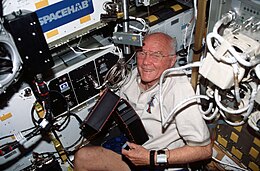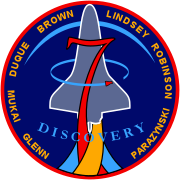
Back STS-95 Arabic STS-95 Bulgarian STS-95 Czech STS-95 Danish STS-95 German STS-95 Spanish STS-95 Estonian استیاس-۹۵ Persian STS-95 Finnish STS-95 French
 John Glenn in the Spacehab Single Module during flight | |
| Names | Space Transportation System-95 |
|---|---|
| Mission type | Bioscience research Astronomy |
| Operator | NASA |
| COSPAR ID | 1998-064A |
| SATCAT no. | 25519 |
| Mission duration | 9 days, 19 hours, 54 minutes, 2 seconds[1] |
| Distance travelled | 5,800,000 kilometres (3,600,000 mi)[1] |
| Spacecraft properties | |
| Spacecraft | Space Shuttle Discovery |
| Landing mass | 103,321 kilograms (227,784 lb)[2] |
| Payload mass | 11,130 kilograms (24,540 lb) {Spacehab)[3] |
| Crew | |
| Crew size | 7 |
| Members | |
| Start of mission | |
| Launch date | 29 October 1998, 19:19:34 UTC[1] |
| Launch site | Kennedy, LC-39B |
| End of mission | |
| Landing date | 7 November 1998, 17:04 UTC[1] |
| Landing site | Kennedy, SLF Runway 33 |
| Orbital parameters | |
| Reference system | Geocentric |
| Regime | Low Earth |
| Perigee altitude | 550 kilometres (340 mi) |
| Apogee altitude | 561 kilometres (349 mi) |
| Inclination | 28.45 degrees |
| Period | 96 min |

 Top: Parazynski, Robinson, Mukai, Duque, Glenn; Bottom: Lindsey, Brown | |
STS-95 was a Space Shuttle mission launched from Kennedy Space Center, Florida on 29 October 1998, using the orbiter Discovery. It was the 25th flight of Discovery and the 92nd mission flown since the start of the Space Shuttle program in April 1981. It was a highly publicized mission due to former Project Mercury astronaut and United States Senator John H. Glenn Jr.'s return to space for his second space flight. At age 77, Glenn became the oldest person to go into space, a record that remained unbroken for 23 years until 82-year-old Wally Funk flew on a suborbital flight on Blue Origin NS-16, launching on 20 July 2021, which in turn was broken by William Shatner at age 90 on 13 October 2021 and then by Ed Dwight on May 19 2024. Glenn, however, remains the oldest person to reach Earth orbit. This mission is also noted for inaugurating ATSC HDTV broadcasting in the U.S., with live coast-to-coast coverage of the launch. In another first, Pedro Duque became the first Spaniard in space.
The mission's objectives involved investigating life-sciences experiments, using the SpaceHab module to perform these experiments on Senator Glenn. Scientific objectives on this mission were not limited to furthering an understanding of the human body, but also to increase astronomical understanding with regards to the Sun, and how it affects life on Earth. The Spartan 201 spacecraft was released by the crew, flying free from the Shuttle, studying the acceleration of the solar wind that originates in the Sun's solar corona. The mission lasted just under ten days, with Discovery completing its voyage by landing at the Kennedy Space Center's Shuttle Landing Facility.
The launch was rare in that the official launch weather forecast provided by the 45th Weather Squadron was 100 percent for favorable weather for launch as well as the Shuttle Landing Facility.[4]
Bill Clinton became the second sitting U.S. president to witness a crewed space launch, joined by his wife Hillary on the roof of the Launch Control Center, and the only one to witness a Space Shuttle launch (President Richard Nixon witnessed the launch of Apollo 12).[5]
- ^ a b c d "Shuttle Missions: STS-95". Mission Archives. NASA. Retrieved 5 May 2018.
- ^ Cite error: The named reference
sfde_sts95was invoked but never defined (see the help page). - ^ Cite error: The named reference
presskit1was invoked but never defined (see the help page). - ^ "Forecast improves to 100 percent 'go' for Shuttle launch". CBS News. 28 October 1998. Retrieved 31 August 2009.
- ^ "President Clinton Attends Launch". NASA. 29 October 1998. Retrieved 28 January 2023.